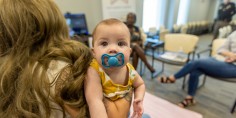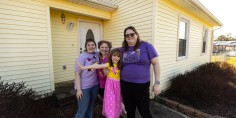Growing up in Halifax County, North Carolina, Sharon Goodson always looked forward to attending Head Start summer camps in her rural community. She remembers playing games with other children in the warm sunshine and tackling fun activities that prepared her for school.
Today, Goodson is executive director of the North Carolina Community Action Association, a network of 34 agencies that provide services and programs — including Head Start — across the state’s 100 counties.
“I guess you can say I entered the world of community action as a child at those camps,” Goodson says. “I had no idea I would one day end up helping those agencies do the incredible work that they do.”
In November 2020, The Duke Endowment awarded nearly $1 million to the North Carolina Community Action Association to help its network address COVID-related needs of low-income families. The grant was part of the Endowment’s efforts to bolster services and resources for Carolinians who have been disproportionately affected by the crisis.
Nearly 80 percent of the Association’s funding went toward housing support, followed by assistance with utilities. Its network was able to help more than 900 families.
Goodson, who has led the Association for nearly 18 years, shares more in the interview below.
Q. Help us understand what community action agencies do.
A. Community action agencies are grassroots nonprofits that work to fight poverty and help families navigate the path to self-sufficiency by becoming independent of public programs. We work with many partners — faith-based organizations, departments of social services, schools, and other public and private entities. But I always say, when you’ve seen one community action agency, you’ve seen just one. Our agencies range in size from five staff members to 300. They’re all different because community needs are different.
Q. Who receives help?
A. Community action agencies serve poor and low-income people up to 200 percent of the federal poverty level. In North Carolina, two in five people (44 percent) live at or below 200 percent of poverty, including more than half of all children under age 18 (54 percent). Our clients are diverse — senior citizens, working adults, children, veterans, the homeless, returning citizens, and individuals who are differently-abled. About 70 – 80 percent served are African American and Latino.
Q. Is there a common goal?
A. Our overarching mission is to move families out of poverty. Services may include comprehensive case management, Head Start, weatherization assistance, childcare food programs, job search assistance and placement, workforce development, financial literacy, tax preparation, eviction prevention, food pantries, transportation assistance, affordable housing, energy crisis assistance, emergency food baskets, emergency clothing, and supplies to help stabilize individuals and families.
Q. How many people do you help?
A. In 2019, we served more than 30,000 families. And we know that because of COVID, the 2020 numbers will be significantly higher.
Q. How did the network respond to that increased demand?
A. Their workloads doubled almost overnight. The agencies worked so hard to continue to serve families, but in a safe manner. They delivered meals to homebound seniors and to Head Start children. When the summer camps closed, they dropped off enrichment supplies and food. They hosted parking lot bingo to keep seniors engaged and distributed laptops so people could seek employment or train for new jobs. They paid utility bills and past due rent and mortgage payments.
Many families already had a relationship with us and trusted us, so we needed to be there to help them navigate these new challenges. We also had to be there for the families who suddenly needed our help for the first time.
Q. Can you give us an example?
A. We have story after story after story of people who just got behind in paying their bills because they could not work. One man in Wilson County was at risk of having his electricity disconnected. He was so worried because he relied on a breathing machine. Our $525 investment made all the difference in the world for him.
Q. What insights do you have about these challenges?
A. We’ve learned that women were disproportionately impacted. We’ve learned that childcare is critical. And housing needs are critical. For most people, rents or mortgages are the largest expense — and if you couple that with a high utility bill, low-income families crumble.
The digital divide was also significant. Some families didn’t have computers or access to the internet, which meant children fell behind academically and parents couldn’t look for jobs. It also led to a sense of isolation and additional stress.
Q. How did you weather this personally?
A. More than ever before, I realized that this is what I was born to do. It’s a true privilege. And if we don’t do it, who will?








